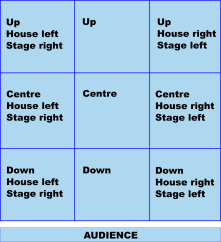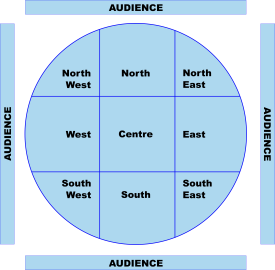Friday Exercise: A Stage in Your Career
Posted on 29 August 2009
Since I discussed stage movement last Friday, I thought this Friday I might lay down some technical details about stages and stage blocking for the beginners.
As a comedian you are going to be potentially facing four types of performance spaces: proscenium theatre, theatre in the round (arena), thrust (platform or open stage), and a space in the corner of a pub. Each of these have unique advantages and disadvantages. If you start touring, you may be surprised with any one of these four and need to be prepared.
Proscenium Theatre
This is the most standard theatre type. You have a large frame, much like a picture frame, or “arch” through which the audience observes the action beyond. The frame is the area across which the curtains are drawn. Frequently, you will also have an “apron”, a short area in front of the frame. The stage is usually raised above the height of the first row of seats and may have an orchestra pit between stage and audience. The audience are seated in rows facing the stage.
Even without the traditional architectural arrangements, if a performance space is divided in two with performers on one side of the room and audience in facing rows on the other side, then that is also considered proscenium.
The whole point of proscenium theatres is that they provide the illusion of a fourth wall through which you are secretly observing events in people’s lives. This means they also create a psychic distance that comedians who are creating a rapport with their audience must surmount. You will see many comedians stand as far forward as possible, often on the apron, while delivering their lines. Others will even jump off the stage and start walking down aisles in order to speak more directly with their fans.
Having nearly fallen into the orchestra pit myself during a performance, I warn comedians to mark a spot on the stage beyond which they will not step. It’s acceptable to put a piece of tape on the floor to remind yourself where the line is.
The advantages of proscenium come to fore when you start having more than one comedian sharing the space. People are very willing to suspend their disbelief with this sort of theatre and allow you to create other worlds no matter how silly or absurd. You can also play around with perceptions of time, distance, emotional weight, etc.
Theatre in the Round (Arena)
Theatre in the round is when the performance is held in the centre of a space with the audience surrounding all sides. I know of a few funky bar venues that use this style of staging, particularly if they’re using a converted dance floor. More frequently your hugely popular comedians have to face this performance arrangement in order to accommodate the size of their audience, and end up at a sports arena or the like.
So, the obvious advantage is the sheer volume of people to whom you can give a clear view of the comedian. The disadvantage is that the comedian will always have their back turned to at least half their audience. Certainly, screens broadcasting a face front view of the comedian at all times helps, but if the comedian doesn’t turn and look directly into each section of the audience, those who did not see the comedian’s eyes will feel they haven’t received their money’s worth.
I would only recommend using this form of theatre if you have dynamic material which lends itself to broad frequent movements. I have seen this done successfully by the likes of Ross Noble and Robin Williams, but they project very high energy personas.
Thrust
Most people are familiar with thrust theatres through the fashion industry. The catwalk can in fact be a form of thrust. You will note that the performance space often begins in a proscenium, then a narrow raised platform continues out into the audience space with people surrounding the performance from three sides.
Thrust can work very well for comic performances. If you’re a bit nervous, you can stand at the beginning of the thrust and do your routine proscenium style. You can also use that thrust to get more dramatic with your stories, or more personal with your audience, by walking up and down the space. I would recommend doing this, since with such an arrangement the audience will expect it. Just remember that the further forward you walk on that stage, the more people will be seeing the back of your head.
The Corner of a Pub
This is the least ideal staging. You will probably have a mic and a basic sound system. You may or may not be on a raised platform of some sort. You will be lucky to get a spotlight.
To work this space you will need to learn a lot about vocal projection and charisma. Anything less and you will get lost in the background once people start talking to one another over a beer. Foot movement should probably be cut out all together. You may have the space to only walk a few steps, and short staccato movements generally weaken a performance by distracting the audience from what you are saying. Hand and facial movement are now crucial, since they will help you to convey meaning over poor acoustics.
Yes, this is the low end of comic performance spaces. However, this is where many people get their start. Places like this for honing your skills are invaluable. Also, if you can get people to laugh in a crowded noisy environment, you can get them to laugh anywhere.
Blocking
Performance spaces are generally divided into a grid of nine sections for blocking, five in the case of a thrust theatre.
At one time stages were set at an angle, since the audience might be seated on a level surface. In this way they could see what was going on at the back of the stage as well as the front. More common these days is raised seating, but even so many stages are still at a slight angle. Therefore, we refer to the portion of the stage furthest from the audience as “upstage” and the portion of the stage closest to the audience as “downstage”. And of course between those sections is “centre stage”. In addition to “up” and “down” you also have “stage right” or “house left” and “stage left” or “house right”. Stage left or right is from the actor’s perspective looking out toward the audience. House left or right is from the audience’s perspective.

Proscenium stage grid.
For theatre in the round you have the same grid, but you will be speaking of the space in terms of north, south, east, west, northwest, northeast, southwest, southeast, and centre.

Theatre in the round (arena) grid.
With thrust you lose four sections of the grid.

Thrust theatre grid.
As a single comedian, you are likely to be using almost exclusively the downstage area and/or centre stage areas. Should you be part of a comedy team involving two or more comic actors, then it’s worth making use of the whole space. When you are crossing the stage be sure to always go toward the middle centre of the stage, pivot toward the next part of the stage you wish to inhabit, then move out. This gives your performance a point of focus for the audience.
You should be aware of some subconsciously understood conventions. Moving from house left (stage right) to house right (stage left) is experienced by the audience as a move from the past into the future. I assume this is from our experience of reading. I’ve asked whether in Asia, where some languages are read right to left, if they have the same convention, and haven’t had an answer from anyone yet. Upstage to downstage is seen as moving from past to present. Moving from house right to house left is generally felt to be a more difficult task by the audience. This would be the direction to go if you mime walking against the wind.
Directly facing the audience is the most powerful postion you can take. The next most powerful is facing directly away from the audience, but should be used sparingly for dramatic effect. Profiles are sometimes made stronger by the performers actually speaking to one another while looking toward the audience in a quarter profile stance. A three-quarters profile looking upstage is your weakest stance.
Some of the big comedians have directors who think about these things for them. You will attract such a director more quickly when you start thinking about yourself within a performance space and how to use it to your best advantage now.
For your Friday exercise find a friend and a square space you can run around in. Have your friend shout out “stage left, up”, “stage right, centre”, “down stage”, etc. You are to run to those parts of the stage via middle centre until you readily understand the directions and get a feel for stage movement.
Peace and kindness,
Katherine
Responses are closed for this post.
